Chpt 2- Deciding What is Right- A Prescriptive Approach PDF

| Title | Chpt 2- Deciding What is Right- A Prescriptive Approach |
|---|---|
| Author | Bailey Archer |
| Course | Business Ethics |
| Institution | Carleton University |
| Pages | 9 |
| File Size | 146.2 KB |
| File Type | |
| Total Downloads | 23 |
| Total Views | 127 |
Summary
Download Chpt 2- Deciding What is Right- A Prescriptive Approach PDF
Description
Ethics and the Individual This chapter begins the part of the book that focuses on ethical decision making as something that individuals do Many if not most ethical decisions in business organizations are made by individuals do There are two ways to think about individual ethical decision makingthe prescriptive approach and the descriptive approach This chapter covers the prescriptive approach It is derived from ethical theories in philosophy and offers decision-making tools (ways of thinking about ethical choices) that help you decide what decisions you should make as a “conscientious moral agent” who thinks carefully about ethical choices and who wants to make the ethically “right” decision Our assumption is that your intentions are good and that your goal is to do the right thing The descriptive approach (discussed in Chapter 3), relies on psychological research to describe how people actually make ethical decisions (rather than how they should make them) It focuses on individual characteristics that influence how individuals think and on cognitive limitations that often keep people from making the best possible ethical decisions
ETHICAL DILEMMAS Many ethical choices are clear-cut enough that we can decide what to do rather easily because they pit “right” against “wrong” But things can get pretty murky in situations where two or more important values, rights, or responsibilities conflict and we have to choose between equally unpleasant alternatives We define an ethical dilemma as a situation in which two or more “right” values are in conflict Consider the following ethical dilemma The Layoff You’re the plant manager in one of ABC Company’s five plants. You’ve worked for the company for 15 years, working your way up from the factory floor after the company sent you to college. Your boss just told you in complete confidence that the company will have to lay off 200 workers. Luckily, your job won’t be affected. But a rumor is circulating in the plant, and one of your workers (an old friend who now works for you) asks the question. “Well, Pat, what’s the word? Is the plant closing? Am I going to lose my job? The closing on our new house is scheduled for next week. I need to know.” What will you say? This is a true ethical dilemma because two values are in conflict
Two “right” values that can create significant conflict are truthfulness and loyalty As illustrated in the case, telling the truth to your friend would mean being disloyal to the company that has treated you so well The value of loyalty can even be in conflict with itself as you weigh loyalty to your friend against loyalty to your boss or company
PRESCRIPTIVE APPROACHES TO ETHCIAL DECISION MAKING IN BUSINESS In this section, we outline some of the major contemporary approaches that we think can provide you with the most practical assistance We then incorporate them into a series of steps that you can use to evaluate ethical dilemmas and, we apply these steps to the short layoff case as well as other examples FOCUS ON CONSEQUENCES (Consequentialist Theories) One set of philosophical theories is categorized as consequentialist (sometimes referred to as teleological, from the Greek telos for “end” and logos for “reason”) When you’re attempting to decide what’s right or wrong, consequentialist theories focus attention on the results or consequences of the decision or action Utilitarianism is probably the best-known consequentialist theory According to the principle or utility, an ethical decision should maximize benefits to society and minimize harms What matters is the net balance of good consequences over bad for society overall A utilitarian would approach an ethical dilemma by systematically identifying the stakeholders in a particular situation as well as the alternative actions and their consequences (harms and/or benefits) for each A stakeholder is any person or group with a stake in the issue at hand The consequentialist approach requires you to do an analysis and mental calculation of all the harms and benefits of these consequences, stakeholder by stakeholder, for each option to be identified After conducting a thorough analysis that estimates these harms and benefits for each stakeholder and for each option, the “best” ethical decision is the one that yield the greatest net benefits for society, and the “worst” decision is the one that yields the greatest net harms for society Keep in mind that this perspective requires you to think broadly about the consequences for “society”, not just for yourself and those close to you, as we are often inclined to do When conducting such an analysis, you should create a table for yourself, using Table 2.1 as a guide, that can help you sort out the complexities by identifying the stakeholders, the options, and the anticipated harms and benefits
BOTTOM LINE: the best decision or action is the one that produces the greatest net good and the least net harm for society overall A more effective approach requires some way to “weight” the harms and benefits and that means thinking hard about what you value more and less ADVANTAGES The consequentialist approach can be extremely practical and helpful in thinking through an ethical dilemma DISADVANTAGES However, a challenge involved in using a strictly consequentialist approach is that it is often difficult to obtain the information required to evaluate all of the consequences for all stakeholder who may be directly or indirectly affected by an action or decision Another difficulty with this type of approach is the rights of a minority group can easily be sacrificed for the benefit of the majority The consequential approach remains particularly important to ethical decision making in business for a variety of reasons First, utilitarian thinking underlies much of the business and economics literature Second, most of us would admit that considering the consequences of one’s decisions or actions for society is extremely important to good ethical decision making FOCUS ON DUTIES, OBLIGATIONS, AND PRINCIPLES (Deontological Theories) The word deontological comes from the Greek Deon, meaning “duty” Deontologists base their decisions about what’s right on broad, abstract, universal ethical principles or values such as honesty, promise keeping, fairness, loyalty, rights (to safety, privacy, etc.), justice, responsibility, compassion, and respect for human beings and property According to some deontological approaches, certain moral principles are binding, regardless of the consequences In other words, a deontologist focuses on doing what is “right” based on moral principles or values such as fairness), whereas a consequentialist focuses on doing what will maximize societal welfare An auditor taking a deontological approach would likely insist on telling the truth about a company’s financial difficulties (in keeping with the value of honesty and fairness to shareholders) even if doing so might risk putting the company out of business and many people out of work A consequentialist auditor would weigh the societal harms and benefits before deciding what to do Knowing what values are important to you and how to prioritize them is an important first step toward understanding and applying this approach in your own life Some deontological theories focus on rights rather than duties, values, or principles
Rights can be thought of as “negative rights,” such as the limits on government interference with citizens’ rights to privacy or the pursuit of happiness Or rights can be thought of in more positive terms, such as the individual’s rights to health and safety How does a deontologist determine what rule, principle, or right to follow? One way is to rely on moral rules that have their roots in Western biblical tradition For example, the Golden Rule, a basic moral rule found in every major religion, is familiar to most of us and provides an important deontological guide: The most familiar version tells us to “Do unto others as you would have them do unto you” Note that he Golden Rule leads you to the best decision only if both parties are highly ethical German philosopher Emmanuel Kant provided another useful moral rule with his categorical imperative, “Act as if the maxim of thy action were to become by thy will a universal law of nature” This rule asks you to consider whether the rational for your action is suitable to become a universal law or principle for everyone to follow A practical Kantian question to ask is, “What kind of world would this be if everyone behaved this way or made this kind of decision in this type of situation? Additional moral rules come from the work of highly regarded American political philosopher John Rawls Rawls proposed that decision makers use a veil of ignorance exercise to arrive at fundamental principles of justice that should guide ethical decision making In his approach, imaginary people do not know anything about themselves, their identities, or their status According to Rawls, rational people who use this veil of ignorance principle will be more likely to develop ethical rules that do not unfairly advantage or disadvantage any particular group Neutral people behind the veil of ignorance would arrive at fair principles that grant all individuals equal rights to basic liberties and equality of opportunity and that benefit the least advantaged in society This approach was designed to be used as a guide in any ethical decision, but it may be most useful when fairness concerns are central to the decision at hand DISADVANTAGES A major challenge of deontological approaches is deciding which duty, obligation, right, or principle takes precedence because, ethical dilemmas often pit these against each other
Another difficulty of deontological approaches arises when they conflict with consequentialist reasoning Sometimes, a decision with good consequences contradicts an important ethical principle FOCUS ON INTEGRITY (Virtue Ethics) The virtue ethics approach focuses more on the integrity of the moral actor (the person) than on the moral act (itself (the decision or behaviour) The goal here is to be a good person because that is the type of person you wish to be A virtue ethics perspective considers the actor’s character, motivations, and intentions According to virtue ethics, it is important that the individual intends to be a good person and exerts effort to develop him- or herself as a moral agent, to associate with others who do the same, and to contribute to creating an organizational context that supports ethical behaviour One’s character may be assessed in terms of principles such as honesty, in terms of rule following, or in terms of consequences Motivations and intentions are important to ethical decision making, as the law acknowledges In virtue ethics, one’s character may be defined by a relevant ethical community- a community that holds you to the highest ethical standards Therefore, it’s important to think about the community or communities in which the decision maker operates A virtue ethics perspective requires you to look to the community that will hold you to the highest ethical standard and support your intention to be a virtuous person A virtue ethics approach is particularly useful for individuals who work within a professional community that has developed high standards of ethical conduct for community members A “Hippocratic Oath for Managers” that calls on managers to commit the following: 1. Service to the Public and Society 2. Balance Multiple Stakeholders’ Interest 3. Acting with Integrity in the Enterprise’s Interest 4. Adherence to the Law 5. Accurate and Transparent Reporting 6. Respectful and Unbiased Decision Making 7. Professional Development 8. Responsibility to Protect the Profession Whether or not you belong to a professional community that provides guidance, it remains essential to think for yourself because a professional community can also be wrong
When a professional community isn’t available, doesn’t provide good guidance, or seems wrong, you can turn to the broader community and societal standards for guidance A useful decision-making shortcut based on the broader community as a guide is known as the disclosure rule This practical shortcut is widely used by managers and executives The disclosure rule asks, “How would you feel if your behaviour appeared publicly on __? If our gut tells us it wouldn’t look good to have our behaviour appear in one of these outlets, we simply shouldn’t be doing it because it means that if we did, we wouldn’t be considered persons of integrity in society’s view If your goal is to be considered a person of integrity, another useful question to ask yourself is how your harshest moral critic or ethical role model would advise you Finally, a virtue ethics perspective assumes that your identity as a moral actor is important to you and that you are devoted to continuously developing that aspect of yourself
We’ve now considered consequentialist, deontological, and virtue ethics approaches These are a few of the philosophical approaches that may be applied in ethical dilemma situations
Next, we offer eight steps that aim to integrate the three types of analysis just discussed
Eight Steps to Sound Ethical Decision Making STEP ONE: GATHER THE FACTS The philosophical approaches don’t tell us explicitly to gather the facts But they seem to assume that we’ll complete this important step Fact gathering is often easier said than done Many ethical choices are particularly difficult because of the uncertainty involved in them Facts may simply be unavailable and you don’t have that crystal ball we talked about earlier It is important to recognize these limitations as you do your best to assemble the facts that are available to you
STEP TWO: DEFINE THE ETHICAL ISSUES Don’t jump to conclusions without first identifying the ethical issues or points of values conflict in the dilemma Also recognize that the toughest situations usually involve multiple ethical issues that go back to the philosophical approaches we just discussed
Points of ethical conflict may go back to the conflict between consequentialist and deontologist approaches Especially when we’re under pressure or in a rush, our inclination is to stop with the first ethical issue that comes to mind
STEP THREE: IDENTIFY THE AFFECTIVED PARTIES (THE STAKEHOLDERS) Both consequentialist and deontological thinking involve the ability to identify the parties affected by the decision The consequentialist will want to identify all those stakeholders who are going to experience harm and benefits The deontologist might want to know whose rights are involved and who has a duty to act in the situation Being able to see the situation through others’ eyes is a key moral reasoning skill Lawrence Kohlberg, developer of a key theory of moral reasoning, called this skill role taking It means putting yourself in others’ shoes and being sensitive to their needs and concerns A more “emotional” take on this would call it sympathy or empathy for the harm experienced by others Frequently, you have to think beyond the facts provided in a case in order to identify all affected parties and what’s fair to them Earlier, we introduced the concept of stakeholders, all of those individuals or groups who have a stake in the particular decision or action In the context of ethical decision making in business, we should identify the stakeholders affected by the decision and ask how they are affected Once stakeholders are identified, role playing can help you see the issue from different stakeholder perspectives Another consideration may be to ask whether you can “test” a potential decision with affected parties before your prospective course of action is made final The objective is to gauge how various audiences will react, so that you can adjust or fine-tune a decision along the way
STEP FOUR: IDENTIFY THE CONSEQUENCES After identifying the affected parties, think about the potential consequences for each party It isn’t necessary to identify every possible consequence You should, however, try to identify consequences that have a relatively high probability of occurring and those that would have particularly negative consequences if they did occur (even if the probability of occurrence is low) LONG –TERM VERSUS SHORT TERM CONSEQUENCES
In business decisions, its particularly important to think about short-term and long-term consequences Are you confident that your behaviour will be considered ethical over a long period of time, even if circumstances or people change? SYMBOLIC CONSEQUENCES In business, it’s also extremely important to think about the potential symbolic consequences of an action Every decision and action sends a message; it stands for something What message will a particular decision or action send? What will it mean if it is misunderstood? CONSEQUENCES OF SECRECY Transparency is extraordinarily important If a decision is made in private in order to avoid some negative reaction, think about the potential consequences if the decision were to become public Think about the disclosure rule here If you’re inclined to keep it a secret, that should be a clue that something isn’t right
STEP FIVE: IDENTIFY THE OBLIGATIONS Identify the obligations involved and the reasons for each one The obligations you identify will vary depending on the people involved and the roles they play
STEP SIX: CONSIDER YOUR CHARACTER AND INTEGRITY Here, think of yourself as a person of integrity Ask yourself what a person of integrity would do in this situation In attempting to answer this question, you may find it useful to identify the relevant moral community and consider what the community would advise Begin by identifying the relevant professional or societal community Then, determine how community members would evaluate the decision or action you’re considering
STEP SEVEN: THINK CREATIVELY ABOUT POTENTIAL ACTIONS Before making any decisions, be sure that you haven’t unnecessarily forced yourself into a corner It’s important to look for creative alternatives
STEP EIGHT: CHECK YOUR GUT The emphasis in these steps has been on using a highly rational factgathering and evaluation process once you know that you’re faced with an ethical dilemma But don’t forget your gut Pay attention to your gut, but don’t let it make your decision for you
Once you recognize that you’re facing an ethical dilemma, use the rational decision-making tools developed here to help guide your decision making
Practical Preventive Medicine Doing your homework Your mission is to be as prepared as possible before you run into a problem The more informed you are, the more effective you’ll be in protective yourself and your employer The best ways to do that are to learn the rules of your organization and your profession, and to develop relationships that can help you if and when the need arises You can learn the rules in various ways First, read your company’s code of ethics and policy manual Second, ask questions Finally, develop relationships with people outside of your chain of command After you’ve done your homework and learned about your company’s standards and values, you may find that your values and your employer’s values are in conflict
When you’re asked to make a snap decision Many businesspeople place value on the ability to make decisions quickly; and, as a result, many of us can feel pressure to make up our minds in a hurry The ethical decision-making tools described earlier in the chapter assume that you’ll have some time to devote to the decision-to consider multiple sides of the issue and the inherent conflicts with any one course of action Do you best to get the time to assess, think through, and gather more information Also consider the following guidelines when a quick decision seems called for: 1. Don’t underestimate that the importance of a hunch to alert you that you’re facing an ethical dilemma 2. Ask for time to think it over 3. Find out quickly if your organization has a policy that applies to your decision 4. Ask your manager or your peers for advice 5. Use the quick-check New York Times test (the discl...
Similar Free PDFs
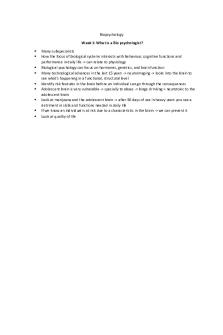
What is a Biopsychologist
- 1 Pages
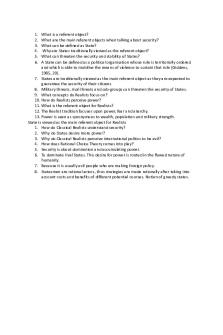
What is a referent object
- 1 Pages

What is a social fact
- 2 Pages

What is ABA - Grade: A
- 5 Pages

What is race - Grade: A
- 1 Pages
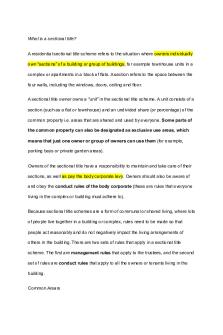
What is a sectional title
- 4 Pages

What is a summary judgement
- 5 Pages

What is a product - lecture
- 4 Pages
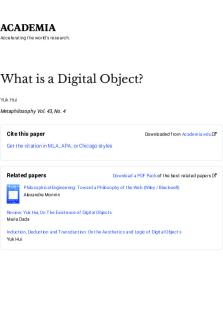
What is a Digital Object?
- 17 Pages

What is a ketogenic diet
- 2 Pages
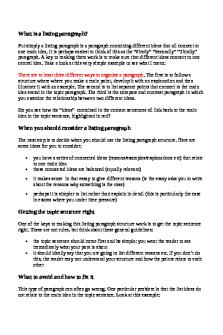
What is a listing paragraph
- 14 Pages

What is a Breadth Indicator
- 4 Pages
Popular Institutions
- Tinajero National High School - Annex
- Politeknik Caltex Riau
- Yokohama City University
- SGT University
- University of Al-Qadisiyah
- Divine Word College of Vigan
- Techniek College Rotterdam
- Universidade de Santiago
- Universiti Teknologi MARA Cawangan Johor Kampus Pasir Gudang
- Poltekkes Kemenkes Yogyakarta
- Baguio City National High School
- Colegio san marcos
- preparatoria uno
- Centro de Bachillerato Tecnológico Industrial y de Servicios No. 107
- Dalian Maritime University
- Quang Trung Secondary School
- Colegio Tecnológico en Informática
- Corporación Regional de Educación Superior
- Grupo CEDVA
- Dar Al Uloom University
- Centro de Estudios Preuniversitarios de la Universidad Nacional de Ingeniería
- 上智大学
- Aakash International School, Nuna Majara
- San Felipe Neri Catholic School
- Kang Chiao International School - New Taipei City
- Misamis Occidental National High School
- Institución Educativa Escuela Normal Juan Ladrilleros
- Kolehiyo ng Pantukan
- Batanes State College
- Instituto Continental
- Sekolah Menengah Kejuruan Kesehatan Kaltara (Tarakan)
- Colegio de La Inmaculada Concepcion - Cebu



